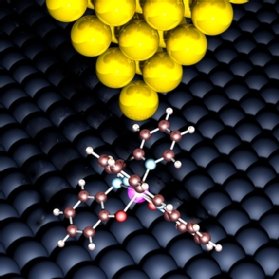
Fotolia
Molecular memory could boost HDD density
Researchers working with molecular storage have discovered a way to create smaller hard drives with more density. But don't expect to see the technology on the market anytime soon.
It's no secret that efforts to increase storage density will soon run into an immutable wall firmly established by the fundamental limits of quantum mechanics. That's bad news for a world that needs to save growing amounts of data in ever smaller physical spaces.
But help may be on the way in the form of molecular memory. Researchers at Germany's Kiel University said they have discovered a method to increase the storage density of conventional hard drives by more than a hundredfold -- eventually.
The new technique focuses on using spin-crossover molecules to create a potential -- and microscopically tiny -- storage unit. Like conventional HDDs, the unique molecules use their current magnetic state to store data. To function properly, the molecules must be placed on a stable surface without hindering their ability to retain information. The Kiel University researchers claim to not only have placed spin-crossover molecules onto a reliable flat platform, but to have raised the potential maximum storage capacity by using specific interactions that were formerly viewed as obstructive.
A step forward
Recent advances in storage density have enabled storage media to shrink significantly in physical size, while simultaneously growing in capacity. Research team member Manuel Gruber of Kiel's Institute of Experimental and Applied Physics recently noted that a single bit on a typical hard drive now only consumes a physical space of approximately 10x10 nanometers. Yet, as data storage demand continues to skyrocket, even today's high-density storage media is failing to keep pace with increasing device miniaturization. Worse yet, storage researchers, concentrating on current methods, are beginning to bump up against that seemingly impenetrable quantum mechanics wall.
To counter these trends, Kiel University researchers are taking storage science down to its most basic level, using a molecule that measures only 1 square nanometer. Using this approach, a bit could be encoded in an area a hundred times smaller than is currently possible. This means that molecular storage could, theoretically, increase the density of a traditional hard drive by over 100 times the original density.
A multidisciplinary project
Kiel researchers started investigating molecular memory technology in 2014. "This ... project involves a large number of teams from different fields, including physics, chemistry and material science," Gruber observed. The project's focus is to understand and improve molecule switching properties. "We want to understand the [molecular] mechanisms that can potentially lead to different kind of applications in the very long term, from data storage to medical applications," he explained.
"Molecular data storage is a possible application of our discoveries," Gruber said. "We made a proof of concept, but we're not developing the technology." Instead, the researchers are performing new experiments in an effort to understand how molecular mechanisms function, which could potentially lead to even better switches.
Three bit states
The new molecular memory can be switched between a high and low magnetic state, as well as turned by 45 degrees. When utilized for storage, the device is able to show information in three states: 0, 1 and 2.
"For standard hard disks, a magnetic disk is segmented," Gruber explained. "A small part of the disk corresponds to a bit." Depending on the direction of the associated magnet, bits are stored on the disk as either a 0 or 1. "Our system is different, as information can be stored in a single molecule, about 1 nanometer large, which is much smaller than the size of a standard bit," Gruber observed. "In addition, we have three possible states, so we can have 0, 1 and 2; therefore, the storage density may be significantly increased."
The biggest challenge the researchers faced was finding both a suitable molecule and surface platform, as well as developing a method to connect the two fragile elements together in a way that would enable them to work correctly and efficiently. Team chemists were eventually able to synthesize a special class of magnetic molecule. Physicists, including Gruber and partner Sujoy Karan, were then able to place the molecule on a stable copper nitride surface.

The current molecular memory is nonvolatile at a much lower temperature (4 degrees Kelvin). "However, the storage may be volatile at room temperature; we do not exactly know [at this point]," Gruber noted.
Long-term outlook
The researchers must still overcome numerous obstacles before the storage process can be used outside of the lab. "For instance, we use extreme experimental conditions: an ultra-high vacuum environment and a very low temperature," Gruber said. "This is to ensure that the environment is not affecting our measurements; otherwise, our understanding of the system would be biased."
Commercial deployment of the molecular memory technology remains years away. "It's very difficult to give any estimate," Gruber noted. "I would say that I cannot foresee any commercial use for the next 10 years."







